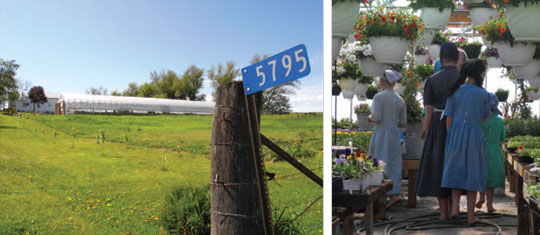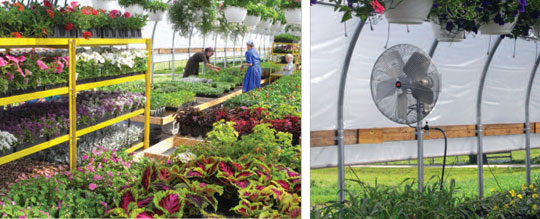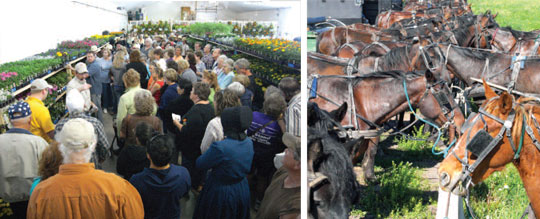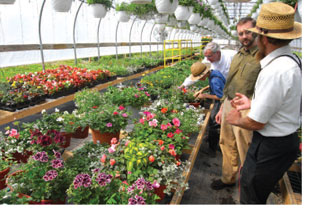7/26/2011
Not a Living, a Life
Chris Beytes
We’ve been wanting to do a story on Amish greenhouse growers for years, ever since first noticing Amish families browsing the booths at OFA and attending field trials and open houses in their traditional clothing, hats and beards. What are they growing, how are they growing it, and how are they selling it?
To find out, last spring I drove west to Iowa, which has five Amish produce auctions (which also sell flowers in spring) and the largest Amish population west of the Mississippi. Accompanying me was Ball’s IGC Business Manager Bill Calkins, who’s always up for an interesting road trip. We spent Monday afternoon in Kalona visiting the farms of several Amish farmers who are now in the flower business, including James Bontrager, James’s brother Titus, and Tobias Yoder. On Tuesday we hit the big pre-Mother’s Day auction at Yoder Auction Services in Frytown. Here’s a pictorial tour:

Flowers are a relatively new addition to the typical Amish farm, but produce preceded flowers as a way for Amish farmers to earn more money from their shrinking (and expensive) properties. Due to the high cost and low profitability of traditional farming, in the ’80s and ’90s, many Amish men and women had been forced to find work away from their farms, doing construction, factory or retail work, which jeopardized their family values-oriented lifestyle. Produce such as tomatoes and cucumbers offered a high yield and better profits in less space than livestock or field crops.
Tobias Yoder told us his farm can generate $150,000 a year from milk, hogs, hay and flowers, with overhead being two-thirds of that. But the Amish are not in it for the money. “We’re not here to make a living, we’re here to make a life,” he says of the Amish philosophy. “I know I could make more money at home, doing a retail business. And I know my neighbors know the same thing. But if we were all retailing, in a sense we’d all be working against one another. We’re in the same community, the same church fellowship … if we can market our product through an auction, we all feel we’re working for each other … . Our goal is for the good of the future community—our children and their children.” (This photo, above right, taken at Titus Bontrager’s farm.)

Anyone who knows the Amish knows that, while they don’t want to be connected to the outside world with electrical or phone wires, they readily adopt the latest technology and adapt it to their needs. Tobias’s greenhouse is equipped with drip irrigation, fertilizer injectors, locally made shipping carts (he’s the first to adopt them), and even pneumatically powered HAF fans and inflation fans (for the double poly roof) run by a gasoline air compressor.

The first Amish auction started in Kidron, Ohio, in the early 1990s, to market the produce the Amish were now growing. The idea quickly spread through Amish communities across the east and Midwest, including Iowa, where in 2001 auctioneer Stan Yoder had opened Frytown Auction (pictured), near Kalona, to handle farm equipment, estate sales and so on. A local Amish farmer, Duane Miller, approached Stan with the idea of doing an Amish produce auction. A group of 20 Amish farmers met to discuss the produce business and auction and get the idea rolling. Flower growing started a few years after produce as a way to have something to sell in spring before corn and tomato season. That’s auctioneer Stan on the left in the beige shirt and cap. It is an auction, so prices vary by demand. We saw flats going for as little as $2, and 4-in. pots going for $1.25 up to $4.25 or more. Nice 12-in. baskets fetched $16 to $18 or more.
Photo above, right: Parking lot behind the Frytown Auction.

Tobias Yoder, who raises milk cows, hogs, corn, beans and alfalfa when he’s not growing flowers, is thoughtful and articulate. But he also has a ready sense of humor. Here he is joking with Bill Calkins about the difference between flower farming and livestock: “For one thing, flowers are a lot easier to load than hogs. And they smell a lot better.”

Along with standard flats, baskets and pots, the Amish are clever and using found objects as planters. And the authentic nature of the objects found on an Amish farm (shoes, hand-crafted bark planters, wheelbarrows) add considerably to the appeal—and price—at auction.

A young Amish boy listens attentively as his father learns about the newest products at the OFA Short Course. A major benefit of flower growing that it’s much easier for the entire family to be involved. “If you’re doing something that’s dangerous with animals, you have to tell the children to stay back, you can’t help, you’re too small,” says Tobias Yoder. “But with flowers, they can help, get in here, get their hands dirty and dig in the dirt. Even the littlest guys, they think they’re doing something helpful.”
Old-fashioned horsepower gets the flowers to market on a wide range of wagons. Steel wheels make for a rough, noisy ride (which I experienced first hand on James Bontrager’s wagon, center).
GT